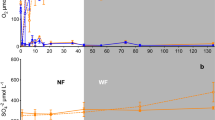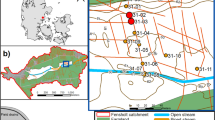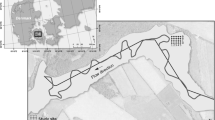Abstract
Purpose
Artificial aeration changes the redox conditions at the soil surface. The introduction of iron (Fe) into wetlands can influence carbon (C) and phosphorus (P) cycling under the fluctuating redox conditions. However, artificial Fe introduced into wetlands is uncommon, and there are no Fe dose guidelines. We compared aerobic and anaerobic conditions to test the hypothesis that Fe addition can, although redox-dependent, affect P forms and the coupling of organic C.
Materials and methods
Twenty-four intact soil cores were collected randomly from a lacustrine wetland of Lake Xiaoxingkai. And representative and homogeneous seedlings of Glyceria spiculosa were collected. The incubation was designed with two treatment factors: Fe/P ratio (5 or 10) and high and low dissolved oxygen (DO) concentrations (> 6 and < 2 mg L−1, respectively). Four groups with three replicates were separated randomly and labeled as aerobic + plant treatment, anaerobic + plant treatment, and aerobic or anaerobic treatment (control).
Results and discussion
The DO concentrations were stratified, decreasing with soil depth and increasing with time, especially under aerobic conditions. The Eh values generally increased with fluctuations under aerobic conditions. The artificial aeration substantially changed the redox environment at the water–soil interface. Of the total P, 45% was in the reactive Fe-bound P, indicating that Lake Xiaoxingkai had high internal P loading. No significant differences were observed in total Fe, amorphous Fe, and organic C at the soil surface between the two Fe/P ratios; however, a significant difference in free Fe was observed. And soil amorphous Fe was found to be a significant correlation with soil organic C, indicating that iron oxides were related with the soil chemical properties.
Conclusions
After short-term incubation, Fe addition can affect the cycling of major elements in wetlands, although this effect is redox dependent. Excessive Fe doses may result in regional environmental risks, such as eutrophication and C sinks of wetland ecosystems. Large-scale controlled experiments are needed to fully understand the behaviors of soil elements in wetlands.







Similar content being viewed by others
References
Antelo J, Arce F, Avena M, Fiol S, López R, Macías F (2007) Adsorption of a soil humic acid at the surface of goethite and its competitive interaction with phosphate. Geoderma 138(1–2):12–19
Cooke GD (1993) Restoration and management of lakes and reservoirs. Lewis Publishers, Chicago
Deppe T, Benndorf J (2002) Phosphorus reduction in a shallow hypereutrophic reservoir by in-lake dosage of ferrous iron. Water Res 36(18):4525–4534
Gao C, Zhang TL, Wu WD (2002) Phosphorus sorption and release of paddy soil: effect of alternation of oxidized and reduced conditions (in Chinese). Acta Pedol Sin 39(4):542–549
Gunnars A, Blomqvist S, Johansson P, Andersson C (2002) Formation of Fe(III) oxyhydroxide colloids in freshwater and brackish seawater, with incorporation of phosphate and calcium. Geochim Cosmochim Acta 66(5):745–758
Hou CC (2012) Effects of hydrological changes on soil carbon sequestration of marsh in Sanjiang Plain (in Chinese). Chinese Academy of Sciences, Beijing GTID:1111330362466061
Jaeger D (1994) Effects of hypolimnetic water aeration and iron-phosphate precipitation on the trophic level of Lake Krupunder. Springer Netherlands, Dordrecht
Jensen HS, Kristensen P, Jeppesen E, Skytthe A (1992) Iron:phosphorus ratio in surface sediment as an indicator of phosphate release from aerobic sediments in shallow lakes. Hydrobiologia 235-236(1):731–743
Jia XY, Li JM (2011) Study on soil phosphorus availability and its relation to the soil properties in 14 soils from different sites in China (in Chinese). Soil Ferti Sci China 6:76–82
Jiang M, Lu XG, Yang Q, Tong SZ (2006) Iron biogeochenical cycle and its environmental effect in wetlands (in Chinese). Acta Pedol Sin 43:493–499
Kleber M, Mikutta R, Torn MS, Jahn R (2005) Poorly crystalline mineral phases protect organic matter in acid subsoil horizons. Eur J Soil Sci 56(6):71–725
Kleeberg A, Herzog C, Hupfer M (2013) Redox sensitivity of iron in phosphorus binding does not impede lake restoration. Water Res 47(3):1491–1502
Lalonde K, Mucci A, Ouellet A, Gélinas Y (2012) Preservation of organic matter in sediments promoted by iron. Nature 483(7388):198–200
Liesack W, Schnell S, Revsbech NP (2000) Microbiology of flooded rice paddies. FEMS Microbiol Rev 24(5):625–645
Liu WJ, Chen SY, Hu FZ, Sha N (2012) Distributions pattern of phosphorus, potassium and influencing factors in the upstream of Shule river basin (in Chinese). Acta Ecol Sin 32(17):5429–5437
Lu RK (2000) Soil agro-chemistrical analysis. China Agriculture Scientech Press, Beijing
Miao SY, Delaune RD, Jugsujinda A (2006) Influence of sediment redox conditions on release/solubility of metals and nutrients in a Louisiana Mississippi River deltaic plain freshwater lake. Sci Total Environ 317(1–3):334–343
Mikutta R, Kleber M, Torn MS, Jahn R (2006) Stabilization of soil organic matter: association with minerals or chemical recalcitrance? Biogeochemistry 77(1):25–56
Piao DX, Wang FK (2011) Environmental conditions and the protection counter measures for waters of Lake Xingkai (in Chinese). J Lake Sci 23(2):196–202
Reddy KR, Delaune RD (2008) Biogeochemistry of wetlands. CRC Press, Boca Raton
Riedel T, Zak D, Biester H, Dittmar T (2013) Iron traps terrestrially derived dissolved organic matter at redox interfaces. Proc Natl Acad Sci U S A 110(25):10101–10105
Rydin E (2000) Potentially mobile phosphorus in Lake Erken sediment. Water Res 34(7):2037–2042
Smemo KA, Yavitt JB (2011) Anaerobic oxidation of methane: an underappreciated aspect of methane cycling in peatland ecosystems? Biogeosciences 8(3):779–793
Su L, Zhang YS, Lin XY (2001) Changes of iron oxides and phosphorus adsorption-desorption in paddy soils under alternating flooded and dried conditions (in Chinese). Plant Nutr Ferti Sci 7(4):410–415
Wang GG, Fu WL, Wei CF, Yuan H (2008a) Iron transformation and phosphorus availability in a drawdown area of three gorges reservoir (in Chinese). Chinese J Soil Sci 39(1):234–238
Wang SR, Jin X, Bu QY (2008b) Effects of dissolved oxygen supply level on phosphorus release from lake sediments (in Chinese). Colloids Surf A Physicochem Eng Asp 316(1–3):245–252
Weiss JV, Emerson D, Megonigal JP (2004) Geochemical control of microbial Fe(III) reduction potential in wetlands: comparison of the rhizosphere to non-rhizosphere soil. FEMS Microbiol Ecol 48(1):89–100
Yu SL (2014) The research on phosphorus release characteristics of surficial sediment and its effects on eutrophication in Lake Xiaoxingkai (in Chinese). Chinese Academy of Sciences, Beijing
Zhang LL, Wang LY, Jia XY, Jiang M, Lu XG, Zou YC (2017) Laboratory simulation experiment on phosphorus removal of phosphorus-rich water with aeration and Carex pseudocuraica planting (in Chinese). Wetl Sci 15:157–162
Zhu XP, Cao CY, Yin JL, Zhou CL (1993) Effect of submergence on iron transformation and phosphorus availability in calcareous soils. Pedosphere 3(4):331–339
Zou YC, Jiang M, Yu XF, Lu XG, David JL, Wu HT (2011) Distribution and biological cycle of iron in freshwater peatlands of Sanjiang Plain, Northeast China. Geoderma 164(3–4):238–248
Zou YC, Yu XF, Huo LL, Lu XG, Jiang M (2012) Waterborne iron migration by groundwater irrigation pumping in a typical irrigation district of Sanjiang Plain. Environ Sci 33(4):1209–1215
Zou YC, Zhang LL, Wang LY, Zhang SJ, Yu XF (2018) Effects of aeration, vegetation and iron input on total P removal in a lacustrine wetland receiving agricultural drainage. Water 10(1):61. https://doi.org/10.3390/w10010061
Acknowledgments
This research was supported by the National Key Research and Development Program of China (2016YFC0500408), the National Natural Science Foundation of China (41271107, 41471079), and the Northeast Institute of Geography and Agroecology, CAS (IGA-135-05). And we would like to thank LetPub (www.letpub.com) for providing linguistic assistance during the preparation of this manuscript.
Author information
Authors and Affiliations
Corresponding author
Additional information
Responsible editor: Zhenli He
Rights and permissions
About this article
Cite this article
Zhang, L., Tang, Z., Zhang, S. et al. Effects of artificial aeration and iron inputs on the transformation of carbon and phosphorus in a typical wetland soil. J Soils Sediments 18, 3244–3255 (2018). https://doi.org/10.1007/s11368-018-1988-1
Received:
Accepted:
Published:
Issue Date:
DOI: https://doi.org/10.1007/s11368-018-1988-1




